31 Oct Turkmenistan – Bye-Bye Birdie. Someday. We hope.
In the annals of human weirdness Turkmenistan is top of the line.
Its capital is called Ashgabat, which means City of Love in Modern Persian. Ashgabat’s claim to fame is that it contains the world’s largest conglomeration — 5,000, according to our guide/minder — of white marble buildings. She asked us if we could guess why that would be the case. “Because Turkmenistan has a big marble quarry?” I posited. No, Silly, she seemed to think. “Because our president likes white marble.” The marble is imported from China and India and, in special cases such as the mausoleum of the first president, it’s genuine Carrera from Italy.
Along with the marble buildings, Ashgabat is also in the Guinness Book of World Records for having the tallest flagpole and the largest indoor Ferris wheel. The wheel is not set up in the oversized atrium of some hypermodern hotel, as I’d supposed,
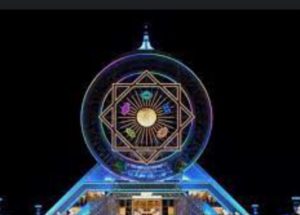
but is enclosed in a sheath that must make riding it feel very claustrophobic and, from a distance, gives the appearance of an outsized alarm clock, which our guide/minder seemed unaccountably pleased about. The flagpole has been supplanted by a taller flagpole in Arabia but not to worry, she consoled us, it’s still the world’s tallest jet-powered flag pole. Because desert winds can’t be trusted to make a flag flutter, and nobody likes a limp flag, the government has installed a jet engine to keep the air moving 153 meters above the ground.
The president also likes white cars. You can tell this because all the cars in Ashgabat are white. He also closed the rural clinics so if you live in a rural area and
get sick you have to hunt around for a white car to drive to Ashgabat. This could be quite a trip in a country that’s big enough to support an airline flying 737’s between cities.
Another thing nobody seems to know is who, exactly, the president is. It’s not like they don’t know his name. Everybody knows his name. It’s Gurbanguly Berdimuhamedov (Birdie-Muhammed-off) and, according to the official bio, he was Deputy Director of the Ministry of Health when the old president kicked off. Deputy Director of Ministry of Health seems like an unlikely platform from which to catapult yourself to the presidency so, perhaps, he was the old president’s nephew. Or, maybe, his son-in-law. Or a dentist, or somebody else. Everybody has an opinion. Nobody seems sure.
When the Soviet Union fell apart the old president turned the country into his private fiefdom and set about de-Sovietizing the place. Among the changes he made were the street names, which he replaced with serial numbers; the days of the week, which he renamed after whatever seemed to have popped into his head (First Day, Justice Day, Spirit Day), and the days of the month three of which he renamed after himself, his mother, and the book he wrote. The book is the Ruhnama (the Book of the Soul) and is always referred to as THE Ruhnama the way the Qur’an is THE Qur’an.
He wrote his book as a spiritual guide for the Turkmen people and it has become a bestseller in certain circles. Those circles include everybody who owns a car because the ability to recite passages from the book verbatim is required to pass the driver’s exam. The book’s being spiritual and all, he had its title carved into the side of the largest mosque in Turkmenistan, along with the words “Holy Book.” Then, in a kind of author-to-author comity, he had “Qur’an” inscribed on the opposing wall along with the words, “Allah’s Book.”
To bring the benefits of its spiritual teachings to the community at large, he placed an enormous statue of the Ruhnama,
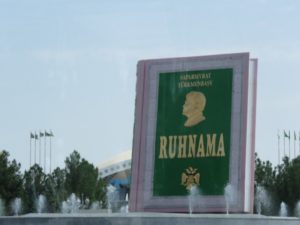
cover a tasteful chartreuse and violet, in the center of a fountain in a park in downtown Ashgabat. At 8:00 every evening, the cover opens, a video starts to play, and a passage from the book is read aloud. By good fortune, Peg and I were never anywhere near that park at 8:00 in the evening.
In a separate park he built a 39-foot tall statue of himself, perched on top of a 230 foot tower. The statue had its arms outstretched, and it rotated so that the old president always faced the sun.
As part of his liberalization program, President Birdie changed the names of the streets back to street names, renamed the days and months back to days and months, and tore down the 230-foot tower with the statue of the old president . . . then thought better about what he’d done and had the statue replaced – this time atop a 290-foot triple arch thingy
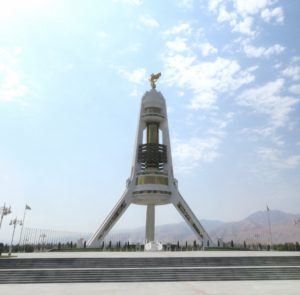
that looks like a rocket ship from a 1930’s pulp sci-fi magazine. He never had the rotator connected back up, though, so now his predecessor just faces north. Also, and I say this from personal experience, he placed a very grumpy guard to keep watch over the thing.
As becomes a second president, he had a more modest, egalitarian sort of golden statue made of himself, arm raised, looking heroic
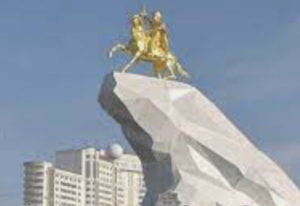
astride a horse on top of a 69-foot high cliff of white marble that was dragged in from somewhere and plunked down in yet another park in Ashgabat. The statue of the book remains in its fountain, still being squirted at with water. As befits its lesser status, the 19-foot-high, golden statue of his dog
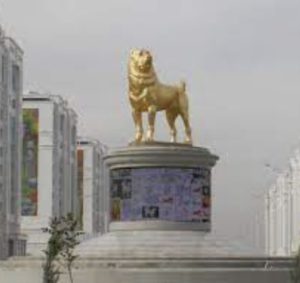
presides over a mere traffic circle.
The 5,000 marble-clad buildings derive from some kind of manic construction program. Many are architectural fancies that would have made Disney drool: Spirals and curves, gold and white, arches and domes and swirls and eight-pointed stars gleaming against the night sky because every building in Ashgabat gleams against the night sky. They are all lit up with spotlights. All five thousand of them. All night.
For the marriage minded, there’s the Civil Registry building
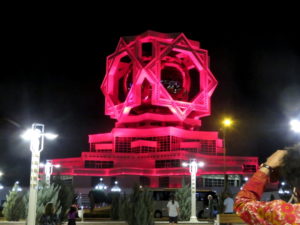
where folks go to get hitched. It changes color while you watch.
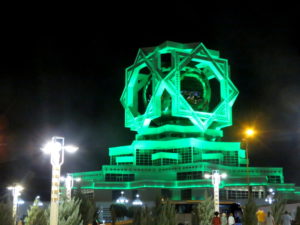
According to our guide/minder, folks in the know call the city Ash Vegas. From space, it must show up as a bright as Singapore.
Some of the domes are perched on top of skyscrapers and some aren’t domes at all, but spheres. One, set into the top of a white, soft-edged vertical structure,makes the place look like a stick of roll-on deodorant. And these are just the commercial buildings. At least they would be commercial if there were any actual commerce in Ashgabat. And if anybody used them. From the street they look as sterile and empty of people as every other major building in Ashgabat.
There are big, sprawling public buildings, too, all fitted out with gold and marble and tilework and pointed arches
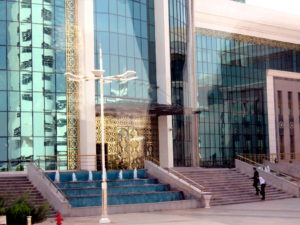
in garish, movie-set Muslim, some of which we were allowed to photograph, some not. “That one,” our guide/minder would say in tobacco-auctioneer English as we motored past, “not that one. No. No. Yes. No yes. Yesno. YesNoNonono. Yes.” She must have had to pass a very strict set of qualifying exams to get the job.
Nobody seemed to be using these, either, which makes sense where Parliament is concerned, but not so much for the ministries and other government offices. The two-story and three-story high, gold-encrusted ceremonial doors were shut as tight as the doors painted on the backdrop of a DeMille bible extravaganza. The side doors were closed, too. “Everybody uses the back doors,” our guide/minder informed us.
The only people on the street, besides police, were occasional women sweeping the gutters with the kind of brooms that witches use in medieval fairy tales. Outside of town people were using donkey carts and picking cotton by hand. According to Human Rights Watch the people picking cotton did not volunteer for that job.
Along with the public buildings are enormous apartment buildings in duplicate and quadruplicate facing one another from opposite sides of intersections, or running to the vanishing point like medieval armies in a computer-generated sword-and-nipples epic. They’re fifteen or sixteen stories high with manicured lawns and welcoming colonnaded entrances, each at least as big as the Plaza in New York. And empty. No signs of life anywhere. No lights, no laundry draped on balconies, no shades half pulled, no plants in windows. Just vacant and lifeless, each with a huge, neon corporate logo on top flashing NOKIA . . . HUA WEI . . . TOYOTA into the desert night. The government had apparently sold the naming rights. Our guide/minder told us it was for the convenience of the residents, “so they can tell each other what building they live in.”
“But they’re empty,” I objected. “Nobody lives in those buildings.”
“You just don’t see anybody because they never have to come out. They have everything they need inside.”
“Like what?”
“Like swimming pools. They have swimming pools inside.”
The odd part is, the swimming pool thing may be true. It was certainly true of the hotel we stopped at to use the bathroom. There it was, a beautiful, indoor pool fed by a gushing waterfall. A lovely, five-star swimming pool with the heat cranked up to Fiji, the waterfall gushing, the lights off, no lifeguard and not a single person swimming. The corridors were empty and darkened. There was a fully equipped gym, unused and unlit; a hotel shop, fitted out with local knickknacks, dark inside with doors locked; and a beautiful, sun-drenched dining room . . . tables set, wine and water glasses at the ready, napkins folded in complicated folds . . . all devoid of people.
A dimly lit clerk sat at the front desk but nobody was checking in or out. There was no concierge and no bellhops and nobody was lounging in the lobby. Off to the side through a gold-filigreed door I finally heard voices, many voices, and, peeking through the filigree, saw people. Scores of people in a darkened hallway on the wrong side of a locked door. Not hotel guests, just ordinary Turkmen in an unadorned, unlit corridor. What they were doing there and why they were locked out of the hotel part of the hotel remains unexplained. The street outside was lined with dozens of similar hotels, gorgeously clad in white marble, none showing any sign of life. It spooked me out.
The street itself was an eight-lane divided highway. President Birdie calls it an autobahn, and he’s not exaggerating. Paralleling it was a two-lane road. On each side. Twelve lanes of pristine motorway WITH NO CARS. No cars at all, not even white cars, at 8:30 on a Thursday morning in the middle of the capital city. Our guide/minder said there really were cars, “Just not here.”
She was right about the cars. Later in the day we encountered some genuine traffic. Not much by the standards of small-town America, but there was a bit in the district where people actually live . . . old, shabby, overcrowded, cracking, stained, tumbledown Soviet apartment blocks with laundry hanging on balconies and lights in the windows and grass eroded away by foot traffic.
Despite the fact that he has brought Turkmenistan to the edge of economic catastrophe, President Birdie recently announced plans to extend the autobahn into the desert, past the Darvaza Gas Crater, past all six yurts, all the way to the northern border where it will come to a dead stop in the sand at Uzbeki part of the Karakum. If anybody actually lived in the Karakum, this might make it easier to get into Ashgabat for medical care. But nobody much does.
So if President Birdie wants to brighten the image of his country with another record, I’m sure Guinness will be pleased to send somebody to Turkmenistan to certify the World’s Longest Highway to Nowhere.


No Comments